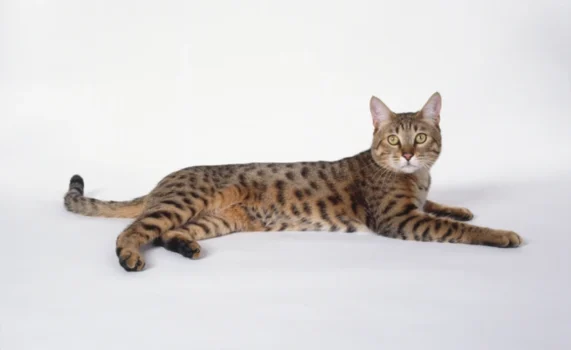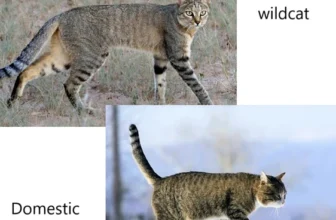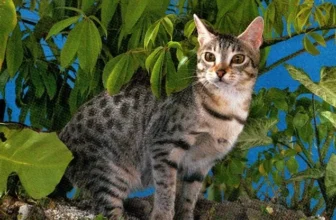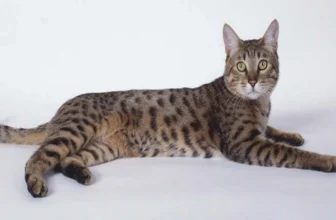The California Spangled breed of cats is a remarkable feline species that has drawn attention since its creation. While numerous cat breeds are derived from similar predecessors, the development of California Spangled is truly unique. In this article, we will explore the intriguing origins of this breed and the intricate story behind its creation. We will delve into the history of its early development, including the inspiration behind its distinct physical traits and its creator’s vision. Additionally, we will discuss the breed’s popularity over the years and its current status. Finally, we’ll provide an overview of the unique traits and characteristics of the California Spangled and review the essential care practices and health concerns related to their upkeep. So fasten your seatbelts and let’s embark on a journey through the exciting tale of the California Spangled breed.
The Creation of the California Spangled Breed
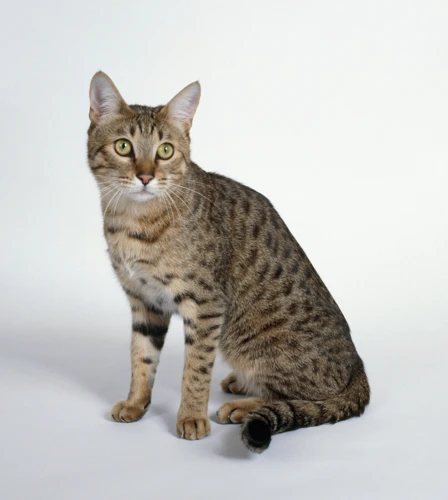
Looking at the California Spangled breed today, it might seem like it’s always been a popular and well-loved feline companion. However, the origins of this unique breed are quite intriguing. The creation of the California Spangled breed was a journey full of inspiration, dedication, and unique breeding practices. Let’s take a closer look at how this breed came to be, including the influences behind its creation and the role of a passionate American breeder in its development.
First Inspiration: The Ocelot
The California Spangled breed is unique in many ways, and its origins are just as fascinating. The first inspiration behind the breed’s creation was the ocelot – a wild cat species known for its striking coat pattern and distinctive markings. The leopard-like spots and stripes of the ocelot were the foundation of the California Spangled’s stunning coat.
To create cats that would resemble ocelots, breeders had to crossbreed several different cat breeds. This led to the development of a breed that was not only beautiful but also healthy and intelligent.
These original crossbreeds included Siamese, American Shorthairs, Abyssinians, British Shorthairs, and Manx cats. Additionally, breeders who wanted to create the California Spangled also incorporated other wild cat species such as the Jungle Cat, Asian Leopard Cat, and African Serval.
Through these crossbreeding efforts, breeders finally came up with cats that had the perfect coat pattern they were looking for. They had a short, thick, and glossy coat with bold spots and stripes set against a bright background, much like a wild feline’s.
Once the coat pattern was established, breeders focused on improving the breed’s physical traits and personality. They aimed to create a breed that was active, playful, and affectionate. To achieve this, they were very careful in selecting cats that exhibited these traits.
Eventually, American breeder Ann Baker took on the responsibility of developing the California Spangled breed. She was the one who had the vision to develop the breed and was the driving force behind its early success.
The California Spangled’s unique and eye-catching coat pattern draws inspiration from the ocelot, with careful crossbreeding efforts resulting in a breed that is healthy, intelligent, and affectionate.
A Unique Coat Pattern: The Leopard Look
During the breeding process of the California Spangled, one of the main goals was to achieve a unique coat pattern that resembled that of wild cats. This was to give the breed a distinct and exotic appearance. The result was a coat that featured bold and contrasting spots or rosettes, giving the cat a “leopard look”.
The California Spangled is the only domestic breed to have this unique coat pattern, making them stand out among other domestic cats. This coat pattern was carefully achieved through selective breeding and was inspired by wild cats such as leopards, jaguars, and ocelots.
Breeding for the California Spangled’s coat pattern involved several generations over several years. Breeders looked for cats that had the desired coat pattern and then selectively bred those cats to produce kittens with that same distinct coat. This process was repeated until the desired leopard look was firmly established in the breed.
The leopard look became one of the defining features of the California Spangled breed, and it was what made it so unique compared to other domestic cats. This coat pattern has remained a key characteristic of the breed and is recognized by cat associations all around the world.
It’s important to note that breeding for this unique coat pattern, like any other trait, can have some potential downsides. As with many other breeds, there were concerns about genetic issues that could arise due to selective breeding. However, with proper care and responsible breeding, these issues can be minimized or eliminated.
California Spangled breeders took care to ensure that they were breeding healthy cats without any genetic issues that could cause harm to the breed. Nevertheless, it is crucial for breeders to understand the genetic traits of this breed, which are unique to the California Spangled.
In summary, the unique coat pattern of the California Spangled breed was one of the main goals during the breeding process. This breed is the only domestic cat breed with such a bold and contrasting pattern, and it was inspired by wild cats such as leopards, jaguars, and ocelots. Despite concerns over potential genetic issues, responsible breeders have ensured that the breed remains healthy and thriving.
Other Influential Breeds
During the creation of the California Spangled breed, breeders drew inspiration from several breeds that they believed would contribute positively to the hybridization process. One such breed was the Abyssinian cat, known for its distinctive coat pattern and muscular build, which inspired the muscular body of the California Spangled. The Siamese cat was also taken into consideration for its lithe body and striking eyes, which can also be seen in the California Spangled cats.
Another influential breed was the American Shorthair, which is known for its thick and lustrous coat, and calm temperament. Breeders of the California Spangled incorporated these traits, resulting in a dense and glossy coat that is unique to the breed. Another breed that played a role was the British Shorthair, which contributed to the round head of the California Spangled.
While these breeds were influential, they didn’t necessarily provide the exact traits that the breeders were looking for. For that reason, they searched for other breeds to mix with their hybrid. After much experimentation, they found that Bengal cats provided the desired traits they were looking for. Bengals are known for their wild appearance, and these traits were found to complement the muscular and athletic build of the California Spangled breed. They also added some genetic diversity to the gene pool, which helped to create a healthier breed.
In addition to the aforementioned breeds, breeders also incorporated traits from several other breeds including the Manx, Burmese, and even the domestic cat. Through careful breeding and experimentation, breeders were able to create a feline that is visually stunning and unique in both appearance and personality.
It is incredible to see how much detail went into breeding and developing the California Spangled breed. The mix of diverse breeds has resulted in a truly remarkable feline that has won the hearts of many. It is fascinating to see how different breeds were brought together, and the positive traits they imparted to create a remarkable and unique hybrid.
The American Breeder Ann Baker and Her Role
Ann Baker was an American breeder who played a significant role in the development of the California Spangled breed. She believed that domestic cats could be bred to resemble the wild and exotic cats seen in nature. Baker’s vision was to create a breed that resembled the ocelot but with a unique temperament suitable for a domesticated pet.
Influence on Breed Characteristics
Baker began her breeding program in the 1960s using a variety of breeds. According to the International Cat Association, Baker bred Siamese, Angora, Manx, British Shorthair, Abyssinian and American Shorthair breeds to create the California Spangled’s unique look. She then added Bengal, Egyptian Mau and Abyssinian to the breed, all well-known for their distinctive coat patterns.
Baker aimed to give these cats a wild appearance, so she bred them to feature the desirable traits of wild cats such as a muscular body, a broad head and a long tail. Finally, through genetic testing, she was able to select the cats with the correct genetic traits to breed.
| Breeds Used in Breeding | Desirable Traits Added to California Spangled Breed |
|---|---|
| Siamese | Muscular body |
| Angora | Broad head |
| Manx | Long tail |
| British Shorthair | Black outline around the eyes |
| Abyssinian | Agouti ticking |
| American Shorthair | Bold markings |
Baker’s Influence on Popularity
Ann Baker’s approach to breeding created a unique and exotic-looking breed that was met with much excitement and popularity in the 1980s. She had the breed officially recognized by the International Cat Association in 1986, opening the door to breeders and cat lovers all over the world.
However, Baker’s eccentric personality and her unorthodox breeding methods led to controversy in the breeding community, causing the breed’s popularity to decline in the late 1980s and early 1990s.
Today, although Baker’s breeding methods are no longer used, her vision and influence on the California Spangled breed’s development will never be forgotten.
To learn more about the California Spangled breed’s decline and revival, read about Paul Casey’s efforts in bringing life back to this once-forgotten breed.
Early Popularity and Decline
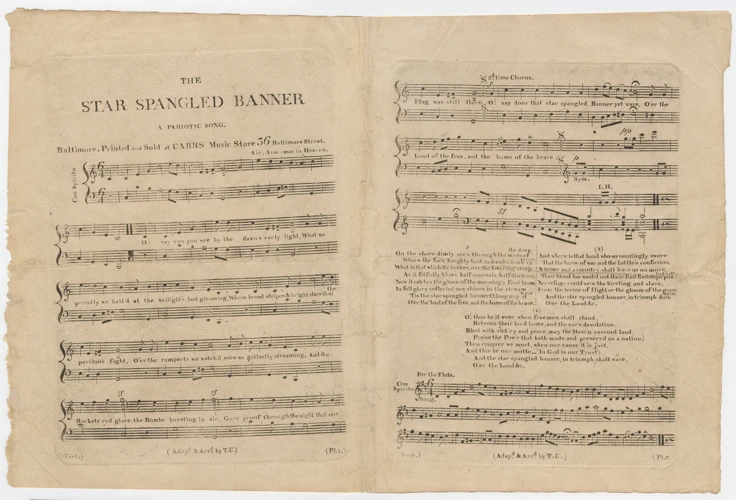
During the 1980s, the California Spangled breed experienced a surge in popularity. Many were drawn to the breed’s wild appearance and playful personality. However, this popularity was short-lived, and the breed soon experienced a decline in numbers. Despite this decline, the California Spangled has left an indelible mark on the world of cat breeding and continues to be appreciated by those who value its unique qualities. In this section, we will explore the early popularity and decline of the California Spangled breed, and what factors may have contributed to its rise and fall.
Experiencing a Boom in the 1980s
During the 1980s, the California Spangled breed experienced a surge in popularity and demand. This was largely due to their unique appearance and fascinating history, as well as clever marketing strategies which positioned the breed as a luxury item.
In 1984, Paul Casey, an ad executive and cat enthusiast, became involved in the promotion and breeding of California Spangled cats. Casey believed that the breed’s leopard-like appearance and exotic origins made it the perfect pet for the rich and famous. He began a breeding program with the goal of creating an even more striking coat pattern, leading to the development of several new varieties. This increased variety helped to fuel interest in the breed, which was soon being featured in glossy magazines and high-end boutiques.
The California Spangled’s newfound fame also brought increased scrutiny and criticism. Many animal activists spoke out against the breeding of such unique and rare animals for the purposes of fashion and vanity. However, the breed’s fans and advocates argued that increased demand and breeding could help to prevent the California Spangled from becoming extinct.
Despite the controversy, the California Spangled remained a popular and sought-after breed throughout the 1980s. Celebrities such as Elizabeth Taylor and Jacques Cousteau became owners of these exotic felines, further increasing their allure.
However, as the 1990s approached, the California Spangled’s popularity began to wane. The cost of these unique cats was often prohibitively high, and many potential owners were put off by the breed’s reputation as a status symbol. Increased competition from other exotic cat breeds also contributed to the decline of the California Spangled.
Today, the California Spangled remains an uncommon and unique breed, loved by those who appreciate their striking appearance and fascinating history. To learn more about the California Spangled’s distinctive coat pattern and genetic traits, check out our articles on breeding for coat patterns and genetic traits.
A Slow Decline over the Years
During the 1980s, the California Spangled cat was at the peak of its popularity. However, as the demand for these felines dwindled, so did their population. The decrease in their numbers was mainly due to the end of various marketing campaigns, the high cost of ownership, and the lack of genetic diversity that led to various health issues.
As a result, breeders started outcrossing with other breeds, which caused further damage to the breed’s genetic makeup. Today, the California Spangled breed is considered rare and endangered, with only a few breeders still actively trying to propagate the breed.
According to Paul Casey, a California Spangled cat breeder, the decline in the popularity of the breed was mainly due to competition from other breeds such as the Bengal and the Savannah cats, which had similar coat patterns and were easier to find and purchase. The high cost of owning a California Spangled cat also contributed to its decline in popularity since most people could not afford to purchase or maintain these cats.
Due to the lack of genetic diversity in the breed, many California Spangled cats suffered from health problems such as heart conditions, leukemia, and degenerative joint disease. These health concerns made potential owners hesitant to invest in the breed, further contributing to its decline. The breeding of the California Spangled cat was also affected by the passing of Ann Baker in the early 90s, who was one of the main driving forces behind the breed’s initial creation.
The decline of the California Spangled breed was gradual and multifaceted. The once popular and unique breed was ultimately sidelined by other breeds that offered similar coat patterns and were easier and less costly to maintain. Despite the breed’s challenges, there are still dedicated breeders trying to preserve and propagate the California Spangled cat for future generations.
The California Spangled Today
The California Spangled cat breed enjoyed a period of popularity in the 1980s, but today, they are considered a rare and unique breed. Despite their waning numbers, California Spangled cats have a passionate following of owners and breed enthusiasts who appreciate their striking appearance and active personalities.
Unique Appearance: One of the main draws of the California Spangled cat is their unique physical appearance. They have a lean yet muscular build with distinctive spots that resemble those of a wild leopard. Their coat colors can range from warm browns and oranges to cool grays and silvers, with black outlining their spots for an added touch of drama.
Family-Friendly: While some cat breeds are more independent and aloof, the California Spangled is known for being outgoing and friendly, making them an ideal choice for families with children or other pets. Their love of attention and affection makes them a favorite of many cat lovers.
Rarity: As mentioned earlier, the California Spangled is a rare breed with relatively low numbers worldwide. However, their rarity only adds to their allure, as it can be exciting to have a unique and uncommon pet. If you’re looking for a breed that not everyone has, the California Spangled might be the perfect choice.
Feisty Personality: Despite being friendly and people-oriented, California Spangled cats are also known for their adventurous and active personalities. They thrive on stimulation and need a lot of playtime and exercise to keep them engaged and happy. They often enjoy puzzle toys and games that challenge their minds and keep them occupied.
Conservation Efforts: Even though the California Spangled breed is rare, there are people dedicated to preserving and promoting the breed. Efforts to breed and protect this unique cat continue, with some breeders working to strengthen the genetic diversity of the breed.
The California Spangled cat is a striking and fascinating breed that is sure to capture the attention of anyone who sees them. While they may be rare, their unique appearance, friendly personalities, and active nature make them a great choice for cat lovers looking for something special.
Physical Traits and Unique Characteristics of the Breed
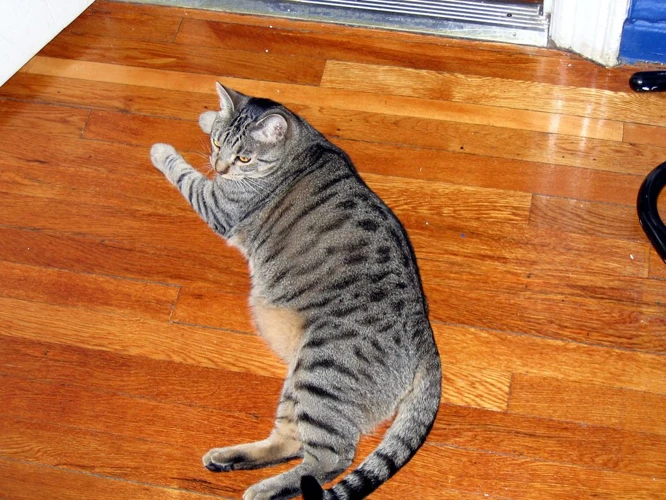
The California Spangled breed is known for its distinctive appearance and unique personality. These cats display a number of physical traits and characteristics that set them apart from other feline breeds. In this section, we’ll take a closer look at the features that define the California Spangled cat, from their striking coat patterns to their playful and affectionate nature. Get ready to be amazed by the fascinating qualities that make these cats so special!
The California Spangled’s Appearance
The California Spangled breed was created to resemble a miniature version of the leopard. Their unique appearance makes them stand out among other domesticated breeds. Here are some physical traits and unique characteristics of the breed:
| Characteristic | Description |
|---|---|
| Coat | The coat of a California Spangled is short and dense, resembling the spots of a leopard. They come in various colors, including bronze, gold, silver, and charcoal. |
| Body | Their bodies are muscular and lean, with a long tail that tapers at the end. |
| Head | Their heads are wedge-shaped, with high cheekbones and large, almond-shaped eyes that come in green, gold, or hazel color. |
| Ears | Their ears are medium-sized, set wide apart on top of the head, and rounded at the tips. |
| Paws | Their paws are medium-sized, with strong, retractable claws that help them climb and jump with ease. |
The California Spangled is a medium-sized cat, with males usually weighing between 10-15 pounds and females weighing between 8-12 pounds. They have striking features that perfectly mimic the coat pattern and physical characteristics of a leopard. Their fierce appearance often leads people to believe that they are difficult to handle, but they are actually affectionate and loving towards their owners.
If you’re looking for a cat that is not only unique in appearance but also has a playful and loving personality, the California Spangled breed may be a perfect fit for you.
Temperament and Personality
The California Spangled cat has an energetic and intelligent personality. They are highly active and playful, making them great pets for families with children. Here are some specific temperament and personality traits of the California Spangled:
- Affectionate: These cats are known for their affection towards their owners and enjoy cuddling up with them on the couch.
- Curious: With their energetic and inquisitive nature, the California Spangled loves to explore their surroundings. They will often investigate different objects, rooms, and even people.
- Highly intelligent: California Spangled cats are intelligent and enjoy mental stimulation. They love puzzles, toys, and games that challenge them both physically and mentally.
- Independent: While they enjoy being around their owners, California Spangled cats are also independent and love having some alone time to explore and play on their own.
- Active: California Spangled cats are athletic and enjoy running, jumping, and climbing around the house. Regular playtime sessions are a must to keep them happy and healthy.
With their unique personality traits, it’s no surprise that California Spangled cats are highly sought after as pets. They are known for being social, friendly, and playful, making them an excellent addition to any household. However, like any cat breed, it’s important to research and understand their personality and needs before bringing one home.
Health Concerns and Care
When it comes to caring for any pet, health is always a top priority. California Spangled cats are generally known to be a healthy breed, but like all living beings, they are susceptible to certain health issues. As an owner, you need to be aware of the potential health concerns that may arise so that you can take preventative measures and ensure that your furry friend stays healthy and happy. In this section, we will take a closer look at some of the most common health concerns associated with California Spangled cats and also provide you with valuable care tips to help you keep your feline friend in top health.
Potential Health Issues to Watch Out For
Just like any other breed, the California Spangled may be prone to some health issues. While these cats are generally healthy and resilient, it’s important to be aware of any potential health concerns to ensure a long and happy life for your furry companion. Here are some potential health issues to keep an eye out for:
| Health Issue | Description |
|---|---|
| Hypertrophic Cardiomyopathy (HCM) | HCM is a form of heart disease that can be inherited. It affects the muscular walls of the heart, making it harder for the heart to pump blood. Symptoms include difficulty breathing, coughing, and fainting. |
| Obesity | Like many domestic cats, the California Spangled can be prone to obesity if their diet and physical activity levels are not monitored. Obesity can lead to a range of health issues, including diabetes, joint problems, and heart disease. |
| Urinary Tract Issues | Urinary tract problems, such as bladder inflammation and urinary blockages, can occur in California Spangled cats. These issues can be caused by a variety of factors, including stress, diet, and genetics. |
| Dental Problems | Without proper dental care, California Spangled cats may develop dental problems such as gum disease, tooth decay, and tooth loss. These issues can cause pain and discomfort and may require veterinary treatment. |
It’s important to note that not all California Spangled cats will develop these health issues. However, if you notice any concerning symptoms in your cat, it’s important to consult with a veterinarian for proper diagnosis and treatment. Regular check-ups and preventative care can also help to keep your California Spangled healthy and happy for years to come.
Best Care Practices for California Spangled Cats
Taking care of a California Spangled cat requires some knowledge on how to maintain their unique coat and overall health. Here are some tips on the best care practices for California Spangled cats:
| Practice | Details |
|---|---|
| Grooming | A California Spangled cat’s coat is short and easy to maintain, so regular brushing is sufficient. Use a soft-bristled brush to remove any loose hair and distribute skin oils. They should also receive regular nail trims and ear cleaning to prevent infections. |
| Diet | California Spangled cats should receive a balanced diet with high-quality cat food that provides all necessary nutrients. They tend to be active and playful, so they require a diet that supports their energy levels. The amount of food should be appropriate for their weight and age, and water should always be available. |
| Exercise | Playing and exercise are important for California Spangled cats to maintain their health and avoid obesity. Provide toys and activities that engage their hunting instincts, such as puzzle feeders or interactive toys. Make sure to give them space to climb and explore. |
| Health Check-ups | Regular check-ups with a veterinarian are important to identify any potential health issues early on. California Spangled cats may be at risk for dental issues and require regular teeth cleanings. They should also receive necessary vaccinations and preventative care for common feline illnesses. |
| Environmental Enrichment | California Spangled cats are social and curious by nature. Provide them with mental stimulation by creating an environment that includes climbing structures, hiding spots, and toys. Give them access to windows to allow natural light and an outdoor view. |
By following these care practices, you can ensure that your California Spangled cat remains happy and healthy for years to come.
Conclusion
After exploring the origins, development, and decline of the California Spangled breed, one cannot help but wonder what the future holds for these unique and magnificent felines. Despite their initial popularity and recognition in the 1980s, the breed failed to establish a substantial following and remain a rare find to this day.
However, the California Spangled’s striking appearance and friendly disposition suggest that it could make a wonderful addition to any household willing to invest in the care and attention these cats deserve. Although potential adopters should be aware of the potential health concerns associated with this breed, proper care and regular veterinary check-ups can ensure a healthy and happy companion.
The California Spangled’s journey from wild feline inspiration to domesticated breed highlights the unique role humans play in the evolution of domesticated animals. From the selective breeding of farm animals to the rise in popularity of exotic pets, humans have shaped and influenced the animal kingdom in countless ways.
As we continue to share our lives with animals, it is important to remember the responsibility we carry for their well-being and the impact our choices have on their lives. The California Spangled breed serves as a testament to the influence and power we have over the creatures we choose to call our companions, and the importance of approaching that relationship with respect, care, and appreciation.
Frequently Asked Questions
1. Are California Spangled cats a rare breed?
Yes, California Spangled cats are considered a rare breed since they are not as common as other domestic cat breeds.
2. What makes the California Spangled breed unique?
Their coat pattern, temperament, and overall physical appearance make the California Spangled breed unique compared to other cat breeds.
3. Can California Spangled cats live with other pets?
Yes, California Spangled cats can live with other pets as long as they are introduced properly and given time to adjust.
4. What lifestyle does the California Spangled cat require?
California Spangled cats require moderate exercise and mental stimulation, making them adaptable to both apartment living and larger homes.
5. Do California Spangled cats have any specific dietary needs?
While California Spangled cats do not have any specific dietary needs, it is important to feed them high-quality food to maintain their overall health.
6. How often should I groom my California Spangled cat?
It is recommended to groom your California Spangled cat once or twice a week to maintain their coat’s health and reduce shedding.
7. Are California Spangled cats prone to any health issues?
Generally, California Spangled cats are healthy breeds; however, they can be prone to genetic health issues such as hip dysplasia or eye problems.
8. Can California Spangled cats be left alone for an extended period?
While California Spangled cats are independent, they still require social interaction and shouldn’t be left alone for extended periods.
9. What is the average lifespan of a California Spangled cat?
The average lifespan of a California Spangled cat is 12-14 years.
10. Are California Spangled cats hypoallergenic?
No, California Spangled cats are not hypoallergenic, but their short hair may produce fewer allergens than other cat breeds.

